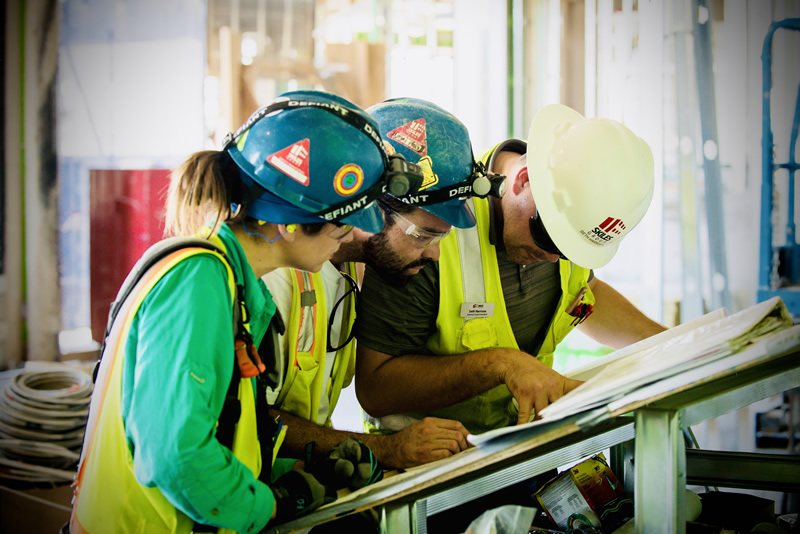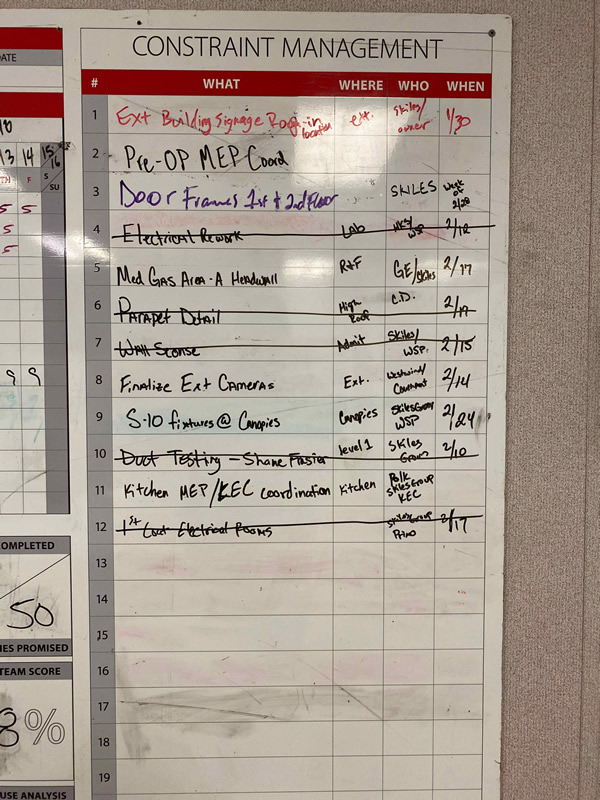One of the best constraint management techniques on the jobsite is to create a constraint management board to track issues, according to Lean expert and author Keyan Zandy. Here’s how.
Managing Constraints on the Jobsite
Those of you who were in the business in the early 2000s probably remember Motorola’s i530 Yellow Rugged Walkie Talkie. This new flip phone-style device was a game changer for communication in the field. Mine use to chirp constantly, going off all day to direct my attention to different foreman with problems they needed to solve. From 730AM -330PM I never got any actual work done, I just hopped from one issue to the next. Understanding, organizing, and then removing these problems in an effective manner was a challenge. Over the years, I’ve used pen and pad, Excel Spreadsheets, and most recently a variety of field apps to help manage and maintain these lists—however, the most effective tool I have used to manage constraints has been putting up a simple constraint board on the jobsite.
A constraint board is a powerful tool and one of the best constraint management techniques that can help the team to communicate, prioritize, and track the constraints that arise during construction. Here are the steps to follow if you’d like to successfully implement a constraint board at your daily huddles:
Creating a Constraint Board
Get a whiteboard that can be written on with dry erase markers, or laminate a large piece of paper—two feet by three feet in size is ideal for either one—and create the following columns:
- What
- Where
- Who
- When
Also get some dry erase markers in a variety of colors, with each color representing a specific trade partner. TIP: Keep a spray cleaning solution and a rag for wiping down the board, since the store-bought erasers get worn out quickly (which is a good thing, as this means the team is collaborating and removing each other’s constraints, yielding a more reliable workflow).
Implementing a Constraint Board
Constraints will be identified during the normal course of conversation at your daily huddles. How diligent and thoughtful you are about capturing and organizing these constraints will determine how successful you are in making the board effective. The following guidelines will help.
What/Where?
When a last planner brings up a new constraint in the daily huddle, it is important to not get too deep in the details of the constraint at first. The huddles are fast-paced, and a lot of time can be spent while describing a constraint and its implications. It is best to just fill out the what column to start and have the team move on. When the huddle is over and the constraint is explored further, more details around what and where can be added for clarity.
Who/When?
The who and when columns must be filled out at the huddle with the last planners. This is the commitment portion of the constraint board; assigning the responsibility for resolving a constraint to someone and having that person make a commitment about when it will be resolved adds strong layers of accountability to the team. This is needed to effectively help the workflow downstream, allowing for the team members to plan and commit with confidence.
Share the Responsibility
At the daily huddle, challenge your teams to write their own constraints on the board. This will allow the trade with the constraint to feel like they have a voice—because they do—and feel that they are being heard, valued, and respected by the others on their team. This behavior will soon begin to shift the project’s culture into one where the trades collaborate and resolve their issues together, rather than making the superintendent the middleman. This removes a significant amount of waste from the previous constraint resolution process.
Review Daily
Even though many constraints will take longer than one day to resolve, make it a habit to review the constraint board with the project team every day at the huddle. This helps remind everyone of the current constraints, allows for new constraints to be added, and allows for those responsible for a constraint to report their progress or announce that a constraint has been removed.
Removing Constraints
Only the person who initiated the constraint should be allowed to remove the constraint. This allows the initiator to maintain ownership over the constraint they identified and prevents a constraint from being removed by someone who may not have all of the necessary information.
Develop and Leverage Your Soft Skills
This constraint process will be tough for some team members to get used to, as many are not used to this level of transparency or accountability. If you are facilitating the meeting and listening to a constraint being raised to the team, be aware of how you are engaging the trade partner. Remember to listen carefully and understand the issue at hand. It is important to use self-awareness to understand others when challenges and conflicts are being raised, as those individuals are often in an overextended state.
For more information, you can refer to this blog to help boost your constraint management skills.
Build the Project Culture
Despite the team’s best efforts, you may have an outlier or two who will not get on board with this new tool as one of your constraint management techniques. Be aware you may have to motivate or incentivize a behavior change, or possibly make a leadership change if the overall jobsite or team culture is being negatively impacted.
At the heart of the Lean philosophy is respect for the individual. If you take a step back, the construction industry is primarily comprised of relationships, commitments, and problem-solving. What sets the great teams apart is respecting people and accepting them where they are and focusing on solving the root causes instead of on the noise that surrounds the challenges or constraints.
By: Keyan Zandy, COO
Skiles Group
For more from Keyan, see The Lean Builder – A Builder’s Guide to Applying Lean Tools in the Field or Connect with Keyan on LinkedIn.










